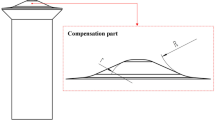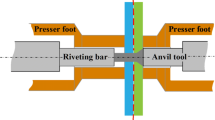Abstract
Sheet metal parts are widely used in the assembly of aircraft. The most common method of joining sheet metal parts is through riveting. There are many parameters associated with a riveting process that affect the quality of rivets and the integrity of the final assembled product. This paper presents a study on the effect of some controllable process parameters in riveting (i.e., the sequence of riveting, distance between rivets (pitch), and gap between sheets) on the quality of riveted lap joints and the formed rivets. The study is performed on a one eight-inch nominal diameter flat head Tinner rivet and 0.064-in.-thick aluminum sheet. Finite element simulation is used as a means of modeling and analysis of the riveting process. Statistical design of experiment is employed to analyze the simulation data. A good combination of riveting process parameters is found which minimizes the residual stress in sheets and rivets, bulging and material growth in sheets, and which reduces the chances of postriveting clearance in a riveted lap joint.
Similar content being viewed by others
References
Andrews HJ, Holt M (1945) Fatigue tests on 1/8th in aluminum alloy riveted joints. National Advisory Committee for Aeronautics (NACA), TN971, ARC8858
Cheraghi HC, Krishnan KK, Bajracharya B (2008) Effect of variations in the riveting process on the quality of riveted joints. Int J Adv Manuf Technol 39(11):1144–1155
Collins JA (1993) Failure of materials in mechanical design: analysis, prediction, prevention, 2nd edn. John Wiley and Sons, New York
Edwards L and Ozdemir T (1992) “Residual stresses at cold expanded fastener holes”, Measurement of residual and applied stress using neutron diffraction, pp 545–553
Ekvall JCE (1986) Fatigue of riveted metallic joints. ASTM STP 927:172–189
ESDU Data Sheets No. 67008. Elastic stresses in single lap joints under tension or compression. Engineering Science Data Unit item 67008, (1967)
Estaugh G, Simpson D, Straznicky P, and Wakeman R (1995) A special uniaxial coupon test specimen for the simulation of multiple site fatigue crack growth and link up in fuselage skin splices. NASA N96-24261
Fitzgerald TJ, Cohen JB (1994) Residual stress in and around rivets in clad aluminum alloy plates. Mater Sci Eng 188:51–58
Frost NE, Marsh KJ, Pook LP (1974) Metal fatigue. Oxford University Press, London
Fung CP, Smart J (1996) An experimental and numerical analysis of riveted single lap joints. Proc Inst Mech Eng 208:79–90
Harish G, Farris TN (1998) Shell modeling of fretting in riveted lap joints. AIAA J 36(6):1087–1093
Harish G, Farris TN (1999) An integrated approach for prediction of fretting crack nucleation in riveted lap joints. American Institute of Aeronautics and Astronautics, Reston. AIAA-99-1340. pp. 1219–1226
Heywood RB (1962) Designing against fatigue. Chapman and Hall Ltd., London
Kang et al (2002) Three-dimensional finite element analysis of the cold expansion of fastener holes in two aluminum alloys. J Eng Mater Technol 124(2):140–145
Li G, Shi G (2004) Effect of the riveting process on the residual stress in fuselage lap joints. Can Aeronaut Space J 50(2):91–105
Li, Gang, Shi, Guoqin, Bellinger, Nicholas C (2005) Studies of Residual Stress in Single-row Countersunk Riveted Lap Joints, 46th AIAA/ASME/ASCE/AHS/ASC Structures, Structural Dynamics and Materials Conference, Austin, Texas, pp. 1–18
Muller RPG (1995) An experimental and analytical investigation on the fatigue behavior of fuselage riveted lap joints. PhD Thesis, Delft University of Technology, the Netherlands
Nicoletto G (1989) Fatigue crack-tip mechanics in 7075-T6 aluminum alloy from high sensitivity displacement field measurements. Nonlinear Fract Mech 1:416–432
Reithmaier L (1991) Standard aircraft handbook, 5th edn. Tab Aero, Blue Ridge Summit
Seliger V (1943) Effect of rivet pitch upon the fatigue strength of single-row riveted joints of 0.025 inch 24S-T alclad. NACA TN 900
Silva LFM et al (2000) Multiple site damage in riveted lap-joints: experimental simulation and finite element prediction. Int J Fatigue 22:319–338
Smith CR (1957) The fatigue strength of riveted joints. Aircr Eng 32(375):142–144
Szolwinski MP and Farris TN (1999) Linking riveting process parameters to the fatigue performance of riveted aircraft structures. American Institute of Aeronautics and Astronautics, Reston. pp 1208–1218
Tong P, Pian T, Lasry (1973) A hybrid-element approach to crack problems in plane elasticity. Int J Numer Methods Eng 17:297–308
Wang HL (1998) Evaluation of multiple site damage in lap joint specimens. Ph.D. dissertation, Purdue University
Author information
Authors and Affiliations
Corresponding author
Rights and permissions
About this article
Cite this article
Aman, F., Cheraghi, S.H., Krishnan, K.K. et al. Study of the impact of riveting sequence, rivet pitch, and gap between sheets on the quality of riveted lap joints using finite element method. Int J Adv Manuf Technol 67, 545–562 (2013). https://doi.org/10.1007/s00170-012-4504-6
Received:
Accepted:
Published:
Issue Date:
DOI: https://doi.org/10.1007/s00170-012-4504-6




